10.11.2021
Wang Yaping becomes the first Chinese woman to walk in space
On November 7, Chinese taikonauts Zhai Zhigang and Wang Yaping conducted the first spacewalk for the Shenzhou-13 mission at the Chinese Space Station. The extravehicular activity (EVA) was the first for a Chinese woman and successfully installed new hardware on the exterior of the Tianhe core module.
The extravehicular activity began when Wang Yaping and Zhai Zhigang exited the airlock, located on the zenith node on the Tianhe core module. During the extravehicular activity, Ye Guangfu remained inside the space station, where he monitored critical systems. The forward node on the Tianhe core module was used as the airlock.
Yaping’s historic spacewalk follows in the footsteps of other women who have walked in space. The first woman to walk in space was cosmonaut Svetlana Savitskaya, who made her first spacewalk in 1984 while docked to the Salyut 7 space station during the Soyuz T-12 mission. The same year, Kathryn Sullivan became the first American woman to walk in space during the STS-41G mission.
Days prior to the spacewalk, the China National Space Administration (CNSA) announced that the Shenzhou-13 crew was preparing for a spacewalk, but did not provide a specific date.
The Shenzhou-13 crew also had their first emergency evacuation drill before this spacewalk. The spacewalk simulated an impact to the station and subsequent depressurization event, which required the crew to evacuate to the Shenzhou-13 spacecraft.
According to Chinese state media, the taikonauts were planning to install two devices during the extravehicular activity, which included a “suspension device” and a “robotic arm combination adapter” on the exterior of the Tianhe core module.
During the spacewalk, one of the taikonauts used the robotic manipulator arm to move around. This arm is similar to both the Canadarm used on the Space Shuttle and the Canadarm2 that is currently in use on the International Space Station.
This spacewalk featured a new spacesuit, worn by Wang Yaping, which was delivered to the station by the Tianzhou-3 cargo resupply craft in September. According to state media, this suit was optimized for Yaping’s shorter height. Zhigang’s suit was previously used by the Shenzhou-12 crew.
Both taikonauts were outside the station for approximately six hours. The spacewalk ended at 17:16 UTC or 01:16 Beijing time.
The Shenzhou-13 crew previously served as the backup crew for the Shenzhou-12 mission. Zhai Zhigang is the commander of the mission and was formerly a fighter pilot in the People’s Liberation Army Air Force selected in the first group of taikonauts. Zhigang previously flew on the Shenzhou-7 mission in 2008. He and Liu Boming became the first Chinese taikonauts to conduct an extravehicular activity during that mission.
Wang Yaping is the second Chinese woman to fly into space, behind Liu Yang in 2012. Yaping’s first mission to space was on the Shenzhou-10 mission in 2013. During the mission, the Shenzhou-10 crew docked to Tiangong-1, China’s first space station. The present-day Chinese Tianzhou cargo resupply craft is derived from the design of the Tiangong-1 space station.

The Shenzhou-13 crew on board the Chinese Space Station. Credit: China Science.
The Shenzhou-13 mission is the first for rookie taikonaut Ye Guangfu. Prior to the mission, he participated in a training event by the European Space Agency (ESA) called the Cooperative Adventure for Valuing and Exercising human behavior and performance Skills (CAVES) in an Italian cave in 2016.
All three of the crew members are in the People’s Liberation Army Astronaut Corps.
The crew launched to space on Shenzhou-13 on October 15 on a Long March 2F rocket from the Jiuquan Satellite Launch Center, located in the Gobi Desert in China. The crew subsequently docked to the nadir docking node on the Tianhe core module later that same day.
This is the first long-duration mission for a crew on China’s new space station. The Shenzhou-13 crew is scheduled to be onboard the station until April 2022. Their long-duration stay is comparable in duration to Soyuz and Crew Dragon mission durations on the International Space Station.
The Tianhe core module first launched on April 29 on a Long March 5B from the Wenchang Satellite Launch Center. In 2022, the station will expand with the additions of both the Wentian and Megtian modules. This expansion phase for the Chinese Space Station will occur during the Shenzhou-14 mission which will be the third crewed expedition to the station and the second long-duration stay.
(Lead image: A taikonaut from the Shenzhou-13 mission climbs out of the airlock on the Tianhe core module on November 7.)
Quelle: NS
+++
China's Shenzhou-13 taikonauts complete first extravehicular mission

Screen image taken at Beijing Aerospace Control Center on Nov. 7, 2021 shows Chinese taikonaut Wang Yaping conducting extravehicular activities (EVAs) out of the space station core module Tianhe. Taikonauts Zhai Zhigang and Wang Yaping have been out of China's space station core module Tianhe by 8:28 p.m. (Beijing Time) Sunday to start EVAs, the China Manned Space Agency said. Zhai opened the hatch of Tianhe's node cabin at 6:51 p.m. This is the second time Zhai has performed EVAs, having completed China's first spacewalk 13 years ago during the Shenzhou-7 mission. Meanwhile, Wang's EVAs make her the country's first female astronaut to leave footprints in outer space. Donning China-developed new-generation Feitian spacesuits, the pair will conduct a series of extravehicular tasks with the aid of the mechanical arm, the agency noted. Ye Guangfu stayed inside to support his crewmates in completing the operations. (Photo by Guo Zhongzheng/Xinhua)
Taikonauts Zhai Zhigang and Wang Yaping have completed their extravehicular activities (EVAs) and returned to the space station core module Tianhe, the China Manned Space Agency (CMSA) said on early hours of Monday.
The event was the third extravehicular mission conducted during the construction of the country's space station and the first by the Shenzhou-13 crew. It also marks the first EVAs in Chinese space history involving a female taikonaut, said the agency, which has declared Monday's EVAs a complete success.
The pair returned to the core module at 1:16 a.m. (Beijing Time) after 6.5 hours of extravehicular activities. They completed a series of extravehicular tasks.
The mission further tested the functions of the China-developed new-generation extravehicular spacesuits, the coordination between the taikonauts and the mechanical arm, and the reliability and safety of supporting equipment related to the EVAs, the CMSA noted.
China launched the Shenzhou-13 spaceship on Oct. 16, sending three taikonauts on a six-month mission to construct its space station. Enditem
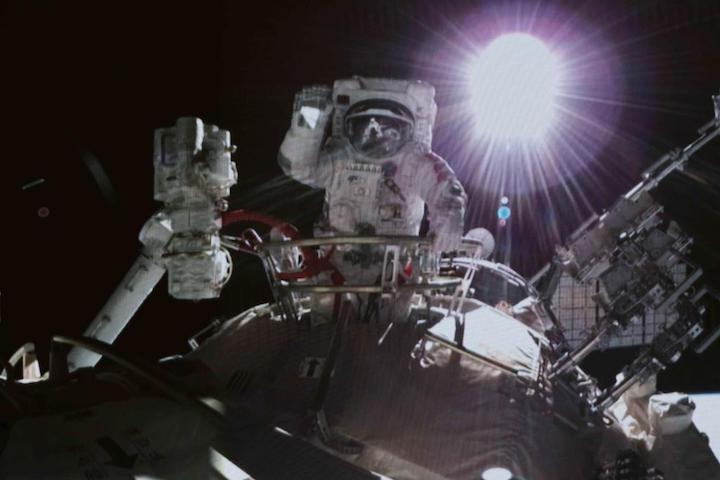
Screen image taken at Beijing Aerospace Control Center on Nov. 7, 2021 shows Chinese taikonaut Zhai Zhigang conducting extravehicular activities (EVAs) out of the space station core module Tianhe. Taikonauts Zhai Zhigang and Wang Yaping have been out of China's space station core module Tianhe by 8:28 p.m. (Beijing Time) Sunday to start EVAs, the China Manned Space Agency said. Zhai opened the hatch of Tianhe's node cabin at 6:51 p.m. This is the second time Zhai has performed EVAs, having completed China's first spacewalk 13 years ago during the Shenzhou-7 mission. Meanwhile, Wang's EVAs make her the country's first female astronaut to leave footprints in outer space. Donning China-developed new-generation Feitian spacesuits, the pair will conduct a series of extravehicular tasks with the aid of the mechanical arm, the agency noted. Ye Guangfu stayed inside to support his crewmates in completing the operations. (Photo by Guo Zhongzheng/Xinhua)
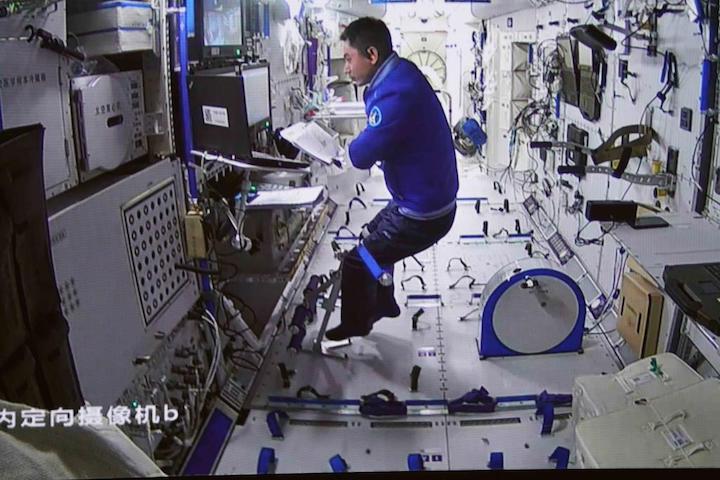
Screen image taken at Beijing Aerospace Control Center on Nov. 7, 2021 shows Chinese taikonaut Ye Guangfu working in the space station core module Tianhe. Taikonauts Zhai Zhigang and Wang Yaping have been out of China's space station core module Tianhe by 8:28 p.m. (Beijing Time) Sunday to start EVAs, the China Manned Space Agency said. Zhai opened the hatch of Tianhe's node cabin at 6:51 p.m. This is the second time Zhai has performed EVAs, having completed China's first spacewalk 13 years ago during the Shenzhou-7 mission. Meanwhile, Wang's EVAs make her the country's first female astronaut to leave footprints in outer space. Donning China-developed new-generation Feitian spacesuits, the pair will conduct a series of extravehicular tasks with the aid of the mechanical arm, the agency noted. Ye Guangfu stayed inside to support his crewmates in completing the operations. (Photo by Guo Zhongzheng/Xinhua)
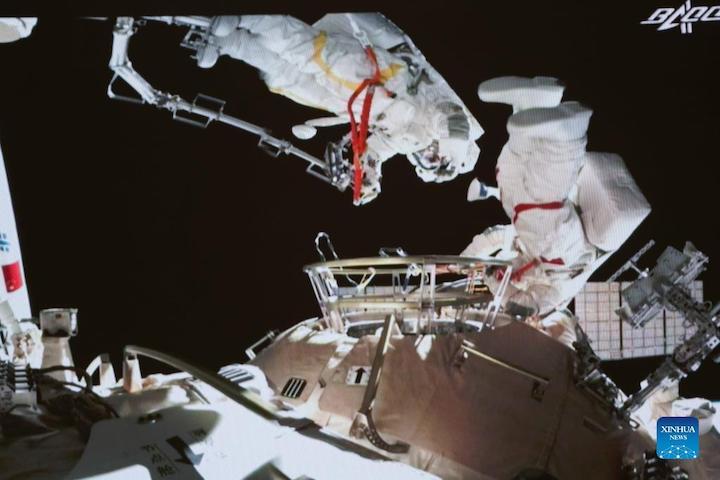
Screen image taken at Beijing Aerospace Control Center on Nov. 7, 2021 shows Chinese taikonauts Zhai Zhigang and Wang Yaping conducting extravehicular activities (EVAs) out of the space station core module Tianhe. Taikonauts Zhai Zhigang and Wang Yaping have completed their extravehicular activities (EVAs) and returned to the space station core module Tianhe, the China Manned Space Agency (CMSA) said on early hours of Monday. The pair returned to the core module at 1:16 a.m. (Beijing Time) after 6.5 hours of extravehicular activities. (Photo by Guo Zhongzheng/Xinhua)

Screen image taken at Beijing Aerospace Control Center on Nov. 8, 2021 shows Chinese taikonaut Wang Yaping (R) completing extravehicular activities (EVAs). Taikonauts Zhai Zhigang and Wang Yaping have completed their extravehicular activities (EVAs) and returned to the space station core module Tianhe, the China Manned Space Agency (CMSA) said on early hours of Monday. The pair returned to the core module at 1:16 a.m. (Beijing Time) after 6.5 hours of extravehicular activities. (Photo by Guo Zhongzheng/Xinhua)
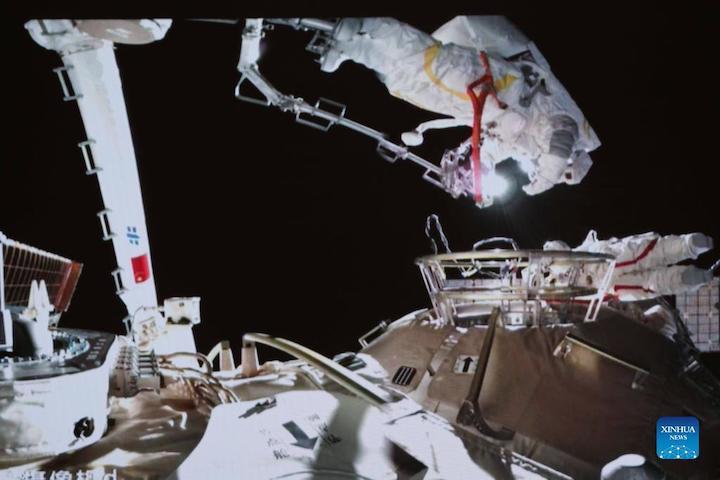
Screen image taken at Beijing Aerospace Control Center on Nov. 7, 2021 shows Chinese taikonauts Zhai Zhigang and Wang Yaping conducting extravehicular activities (EVAs) out of the space station core module Tianhe. Taikonauts Zhai Zhigang and Wang Yaping have completed their extravehicular activities (EVAs) and returned to the space station core module Tianhe, the China Manned Space Agency (CMSA) said on early hours of Monday. The pair returned to the core module at 1:16 a.m. (Beijing Time) after 6.5 hours of extravehicular activities. (Photo by Guo Zhongzheng/Xinhua)

Screen image taken at Beijing Aerospace Control Center on Nov. 8, 2021 shows Chinese taikonaut Zhai Zhigang waving his hand after completing extravehicular activities (EVAs). Taikonauts Zhai Zhigang and Wang Yaping have completed their extravehicular activities (EVAs) and returned to the space station core module Tianhe, the China Manned Space Agency (CMSA) said on early hours of Monday. The pair returned to the core module at 1:16 a.m. (Beijing Time) after 6.5 hours of extravehicular activities. (Photo by Guo Zhongzheng/Xinhua)
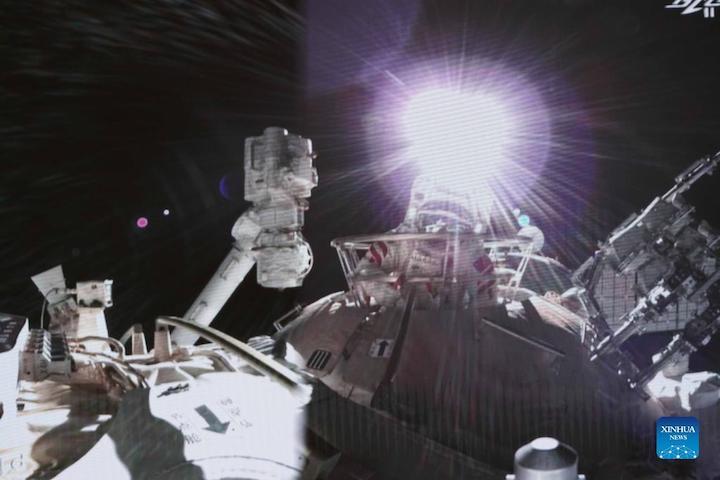
Screen image taken at Beijing Aerospace Control Center on Nov. 8, 2021 shows Chinese taikonaut Zhai Zhigang completing extravehicular activities (EVAs). Taikonauts Zhai Zhigang and Wang Yaping have completed their extravehicular activities (EVAs) and returned to the space station core module Tianhe, the China Manned Space Agency (CMSA) said on early hours of Monday. The pair returned to the core module at 1:16 a.m. (Beijing Time) after 6.5 hours of extravehicular activities. (Photo by Guo Zhongzheng/Xinhua)
Quelle: Xinhua
+++
Chinese astronauts' EVAs to help extend mechanical
arm
The extravehicular activities (EVAs) carried out by two Chinese astronauts from Sunday evening till early Monday morning will help expand the capabilities of the mechanical arm on the country's space station, said the China Academy of Space Technology (CAST).
Astronauts Zhai Zhigang and Wang Yaping were out of China's space station core module Tianhe by 8:28 p.m. (Beijing Time) Sunday, and completed their EVAs and returned to the space station core module Tianhe at 1:16 a.m. (Beijing Time) Monday.
They performed a series of extravehicular tasks, including installing the dual-arm connector (the device linking the big and small mechanical arms) and the suspension device.
The devices will help realize the connection of the big arm on the core module Tianhe and the small arm on the lab module Wentian, which is expected to be launched in 2022 to dock with Tianhe.
The connected mechanical arms will be able to transfer a heavier load for a larger area range.
According to Gao Sheng, an engineer in charge of the mechanical arm operation with the CAST, after connection, the big arm, 10 meters long, and the small arm, five meters long, will form a combined mechanical arm, with its operation range extended to 14.5 meters.
The combined mechanical arm can cover three modules of the space station, inspecting their surface at any time, and can carry out difficult and diverse missions, Gao said.
China launched the Shenzhou-13 spaceship on Oct. 16, sending three astronauts on a six-month in-orbit mission to construct its space station. Enditem
Quelle: Xinhua
----
Update: 26.11.2021
.
China to openly select sci-tech projects for space station cargo craft
China Manned Space Agency (CMSA) recently released an announcement to openly select projects of sci-tech experiments and applications to board the country's Tianzhou cargo spacecraft from society.
The project application is open for government organizations, research institutions, educational institutions, enterprises and industry groups, said the CMSA.
Any project that faces the sci-tech frontier, meets the requirement of national development strategy and sci-tech development trend, or is forward-looking, innovative or has industrial development value can submit the application on or before Jan. 15, 2022, the agency said.
Tianzhou-3 and Tianzhou-2 were launched on Sept. 20 and May 29 respectively this year, to transport supplies and materials for the construction of China's space station.
Tianzhou cargo spacecraft series was independently developed by China. Their operation orbit is no higher than 450 km, with a maximum load of 6.5 tonnes and one-year in-orbit flight time.
The in-orbit construction of China's space station is going smoothly as planned. After completion, it will enter the stage of application and development, with two Tianzhou spacecraft launched on averagely each year.
Aside from the cargo supply, they will also provide an open and shared platform for space science and technology experiments and application projects.
This is the first time for China's manned space mission to open its cargo craft payloads to the public, said the CMSA.
Previously, the CMSA cooperated with the United Nations Office for Outer Space Affairs on the application of China's space station to provide opportunities to carry out application experiments. There have been nine projects from 17 countries being selected, which are in the fields of space life science and biotechnology, space astronomy, and microgravity fluids and combustion. Enditem
Quelle: Xinhua
----
Update: 3.12.2021
.
China to livestream first space class from Tiangong space station
China will livestream to the world the first space class from its space station Tiangong in the upcoming days, the China Manned Space Agency (CMSA) announced Thursday.
China will launch a space science education brand "Tiangong Class" -- the first of its kind -- to give full play to the Chinese space station, according to the CMSA.
In the "Tiangong Class," Chinese astronauts will become the "teachers in space" and interact with students, especially teenagers.
With the progress of the manned space flight mission, the "Tiangong Class" will introduce a series of classes focusing on the construction of the Chinese space station and its in-orbit operation, the CMSA said. Enditem
Quelle: Xinhua
----
Update: 7.12.2021
.
Chinese astronauts to give space lecture on Dec. 9
A special lecture will begin at 3:40 p.m. (Beijing Time) on Thursday, given by the three Shenzhou-13 crew members aboard China's space station, the China Manned Space Agency (CMSA) announced on Monday.
The three astronauts, namely Zhai Zhigang, Wang Yaping and Ye Guangfu, will interact with students on Earth. The primary ground classroom will be at the China Science and Technology Museum. Classrooms will also be set up in Nanning of south China's Guangxi Zhuang Autonomous Region, Wenchuan County of Sichuan Province, Hong Kong and Macao, said the CMSA.
The astronauts will introduce and display their living and working scenes in the Chinese space station. They will also demonstrate projects like cytological experiments, the motion of objects and the surface tension of liquids in the microgravity environment. They will have real-time interaction with the ground classrooms to spread the knowledge of crewed spaceflight and inspire young people.
Three Chinese astronauts went into space onboard the Shenzhou-13 spaceship and entered the country's space station on Oct. 16, embarking on the country's longest-ever crewed mission for space station construction.
In June 2013, Chinese female astronaut Wang Yaping, assisted by the other two crew members aboard the Shenzhou-10 spacecraft, delivered the country's first space lecture to over 60 million schoolchildren across China via live video streaming. Enditem
Quelle: Xinhua
----
Update: 9.12.2021
.
Shenzhou-12 astronauts meet press after initial recovery
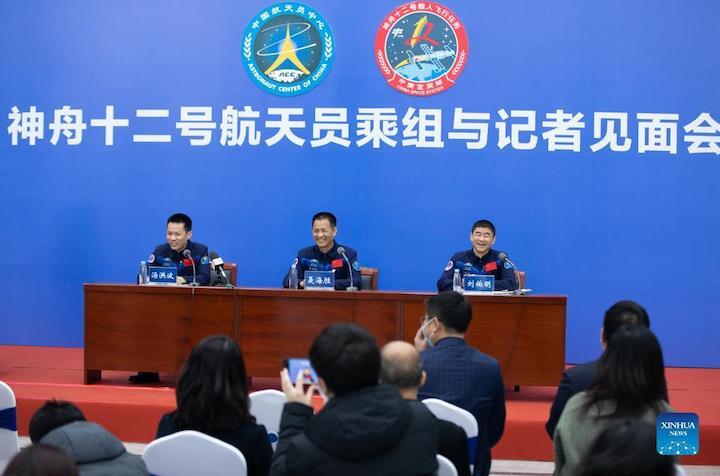
Chinese astronauts Tang Hongbo (L), Nie Haisheng (C) and Liu Boming attend a press conference held by the China Astronaut Research and Training Center in Beijing, capital of China, Dec. 7, 2021. Tang Hongbo, Nie Haisheng and Liu Boming, the three astronauts of the Shenzhou-12 spaceflight mission, on Tuesday met with the public and the press here for the first time after their return to Earth. (Xinhua/Jin Liwang)
The three astronauts of China's Shenzhou-12 crewed mission met the press on Tuesday, the first such appearance since their initial recovery after returning to Earth in September.
At the press conference held at the Astronaut Center of China in Beijing, Jing Haipeng, head of the Astronaut Corps of the Chinese People's Liberation Army, introduced the Shenzhou-12 crew's recovery and follow-up plans.
According to Jing, the recovery following the astronauts' return to Earth has three stages: quarantine, recuperation and observation. So far, the crew has completed the second stage. They are emotionally stable and in a good psychological condition, their weight is at the same level as before the flight, and they have further restored their muscle strength, endurance and cardio functions.
Jing said the three astronauts have entered the observation stage and will resume their regular training after completing the health assessment.
Nie Haisheng, who has flown into space three times, is China's first astronaut to stay in space for more than 100 days. He said that he would transform his achievements and honors into greater motivation and passion, and he would not give up on his aims due to aging.
Liu Boming is the country's first astronaut to complete extravehicular activities (EVA) twice. He said he was more calm and confident about his second EVA during the Shenzhou-12 mission, and he believes that Chinese people will leave more footprints in space.
The Shenzhou-12 mission was Tang Hongbo's first visit to space. He said he is ready to go back.
Launched on June 17, Shenzhou-12 sent astronauts to China's space station core module Tianhe, where they lived for three months, the longest time Chinese astronauts have spent in space so far. The three returned to Earth safely on Sept. 17. Enditem
Quelle: Xinhua
----
Update: 12.12.2021
.
Chinese astronauts give science lesson from space station
Chinese astronauts are beaming back a science lesson from the country's under-construction space station
BEIJING -- Chinese astronauts on Thursday beamed back a science lesson from the country’s under-construction space station.
The lecture focused on physics, aiming to illustrate how the weightless environment affects buoyancy, the movement of objects and optics.
Students from five cities, including Beijing and the semi-autonomous region of Hong Kong, peppered the astronauts with questions about living conditions in space and were treated to a virtual tour of the station. The event was also open to the public through a livestream.
Wang Yaping, the only woman aboard the station, served as the main instructor, while Ye Guangfu assisted and commander-in-chief Zhai Zhigang worked the camera. Wang had taught a similar lesson while aboard one of China’s earlier experimental stations in 2013.
The three arrived at the station in October for a six-month stay, charged mainly with preparing the main Tianhe module for the arrival of two additional modules named Mengtian and Wentian ahead of completion by the end of next year.
Wang last month became the first Chinese woman to conduct a spacewalk when she and Zhai spent six hours outside the module to install equipment and carry out tests alongside the station’s robotic service arm.
Their Shenzhou-13 mission is China's longest since it first put a human in space in 2003, becoming only the third country to do so after Russia and the U.S.
The three are the second crew on the permanent station, which upon completion will weigh about 66 tons, much smaller than the International Space Station, which launched its first module in 1998 and weighs around 450 tons.
Along with installing equipment in preparation for the station’s expansion, the crew is assessing living conditions in the Tianhe module and conducting experiments in space medicine and other areas.
China’s space program was barred from the International Space Station, mainly due to U.S. concerns over its intimate military connections.
China has also pushed ahead with un-crewed missions, and its lunar exploration program generated media buzz this week when its Yutu 2 rover sent back pictures of what was described by some as a “mystery hut, but was most likely only a rock of some sort.
The rover is the first to be placed on the little-explored far side of the moon, while China's Chang’e 5 probe returned lunar rocks to Earth for the first time since the 1970s last December. A Chinese rovernother, meanwhile, is searching for evidence of life on Mars.
The program has also drawn controversy. In October, China’s Foreign Ministry brushed-off a report that China had tested a hypersonic missile two months earlier, saying it had merely tested whether a new spacecraft could be reused.
China is also reportedly developing a highly secretive space plane.
Quelle: abcNews
----
Update: 19.12.2021
.
1st LD-Writethru: New technologies make Chinese astronauts' in-orbit lives easier
Chinese astronauts live and work more conveniently and comfortably in orbit with the application of advanced information technology, said the China Aerospace Science and Technology Corporation (CASC).
There are smart home systems in China's space station core module Tianhe, Bai Linhou, deputy chief designer of the space station at the China Academy of Space Technology (CAST) under the CASC, said at a press conference Friday.
Astronauts can control the lighting and kitchen equipment of the core module through mobile apps. They can also navigate the internet and video chat with their family and friends, Bai said.
With an acousto-optic system equipped in the core module, the astronauts can sleep at night instead of being on duty, Bai added.
Tang Hongbo, one of the three astronauts of China's Shenzhou-12 crewed mission, said that the crew members could have a hot meal in about half an hour.
He also said astronauts sleep well in orbit thanks to a loudspeaker that informs them if anything goes wrong.
Convenient living and working is a significant part of China's manned spacecraft design, Bai said.
Researchers have furnished the core module well so that astronauts can work comfortably, Bai added. Enditem
Quelle: Xinhua
----
Update: 26.12.2021
.
China's Shenzhou-13 astronauts to conduct 2nd extravehicular activities Sunday

Screen image captured at Beijing Aerospace Control Center in Beijing, capital of China, Oct. 16, 2021 shows three Chinese astronauts, Zhai Zhigang (C), Wang Yaping (R) and Ye Guangfu, waving after entering the space station core module Tianhe. (Xinhua/Tian Dingyu)
China's Shenzhou-13 astronauts will conduct extravehicular activities (EVAs) for the second time on Sunday, announced the China Manned Space Agency (CMSA).
As planned, astronauts Zhai Zhigang and Ye Guangfu will conduct EVAs, with astronaut Wang Yaping staying inside to support her crewmates to complete the operations.
The three Chinese astronauts have been working and living in orbit since they were sent into space onboard the Shenzhou-13 spaceship and entered the combination of the country's space station on Oct. 16.
They are currently in good condition, and the combination is operating stably. All conditions for the crew's second EVAs are in place, the CMSA said.
Since the crew conducted the first EVAs on Nov. 7, they have performed their daily work, including in-orbit medical checks, space experiments and space station inspections.
They also carried out in-orbit training programs such as emergency evacuation and medical rescue drills, and successfully gave the first live class from the country's space station on Dec. 9.
The first EVAs by the Shenzhou-13 crew lasted for 6.5 hours, and was a complete success, which further tested the functions of the China-developed new-generation extravehicular spacesuits, and the reliability and safety of supporting equipment related to the EVAs, the CMSA noted.
Starting from Oct. 16, the three astronauts embarked on the country's longest-ever crewed mission lasting for six months for space station construction. Enditem
Quelle: Xinhua
----
Update: 28.12.2021
.
Chinese astronaut pair complete six-hour spacewalk

HELSINKI — Two Shenzhou-13 astronauts embarked on a six-hour extravehicular activity Sunday to install equipment outside China’s Tianhe space station module.
Astronaut Ye Guangfu, wearing a Fetian EVA suit with yellow markings, opened the Tianhe airlock hatch at 5:44 a.m. Eastern Dec. 26 before exiting the space station module, according to the China Manned Space Agency.
Mission commander Zhai Zhigang, with red markings on his Feitian suit, followed his colleague outside at 6:37 a.m., embarking on his third spacewalk. Wang Yaping, the third Shenzhou-13 crew member, assisted from inside Tianhe, operating the module’s large robotic arm.
The pair raised a third panoramic camera outside Tianhe, performed further tests of equipment and made preparations for future missions. Operations were completed by 11:55 a.m. CMSA stated.
The EVA is the fourth conducted since the launch of the Tianhe core module in April this year. China will next year conduct tests involving Tianzhou cargo spacecraft currently docked with Tianhe and launch two new modules designed to host science research.
The EVA was Ye’s first spacewalk, having assisted Zhai and Wang Yaping from inside Tianhe during the first Shenzhou-13 EVA Nov. 7 Zhai became the first Chinese citizen to carry out a spacewalk during the 2008 Shenzhou-7 mission and participated in the November EVA with Wang.
Chinese state media broadcast a portion of the EVA, including English language coverage from CGTN.
Shenzhou-13 launched Oct. 15 and the three crew are expected to remain onboard until March 2022. The mission is the second to the Tianhe module, following the June-September Shenzhou-12 mission.
China’s human spaceflight agency and state media have begun providing more regular updates from the Shenzhou-13 mission, indicating greater confidence to realize outreach, political and soft power potential from the space station project. A number of official outlets also highlighted that the Shenzhou-13 spacewalk occurred on the anniversary of the birth of People’s Republic of China founder Mao Zedong.
Authorities previously limited the publishing of video and imagery from the Shenzhou-12 mission and first weeks of Shenzhou-13.
The Shenzhou-13 astronauts delivered a live science lecture from Tianhe Dec. 9, providing a tour of Tianhe and demonstrating a number of unique phenomena in microgravity.
The “Tiangong classroom” was targeted at school children, particularly to boost interest in STEM education. A question and answer session included questions from children at schools in Beijing, Guangxi Zhuang Autonomous Region and Sichuan Province in the southwest and Hong Kong and Macao from outside the mainland.
Live English language coverage of the event meanwhile presents a friendly, benevolent face to China’s space efforts, in contrast to recently reporting on hypersonic vehicle testing. More Tiangong classes are planned for the future.
Quelle: SN
+++
Shenzhou-13 crew conducts second spacewalk of mission
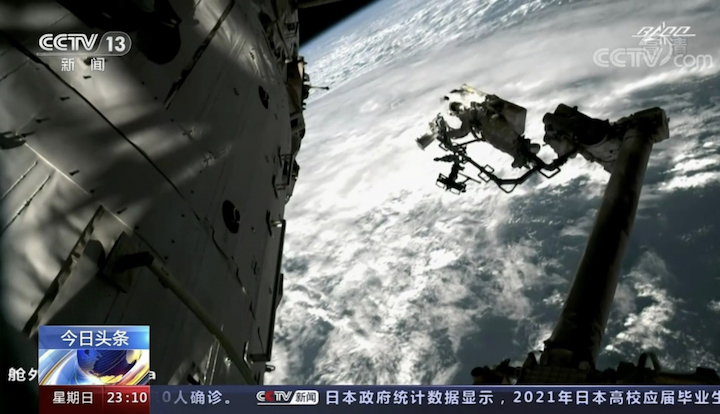
The Shenzhou-13 crew has conducted the second EVA of its mission, with taikonauts Zhai Zhigang and Ye Guangfu exiting the Tianhe core module to conduct a six-hour spacewalk. Meanwhile, Wang Yaping stayed inside the station to assist, over a month after she became the first Chinese woman to walk outside her spacecraft.
During the EVA, the taikonauts were to deploy an external camera known as “panoramic camera C,” install a foot restraint platform, and test various methods of translation (movement) of objects outside the station. These objectives appear to have been successfully conducted.
The EVA started at 10:44 UTC on December 26 and concluded at 16:55 UTC after conducting some object translation tests outside the station, for a total time of six hours and 11 minutes spent outside. This was the first EVA for rookie taikonaut Ye Guangfu and the third EVA for Zhai Zhigang, who walked outside with Wang Yaping on the November 7 EVA.
Zhai has prior EVA experience not only from that EVA but also from the Shenzhou-7 mission in 2008, when he became the first-ever Chinese taikonaut to walk in space, donning his Chinese-made Feitian spacesuit and walking outside the Shenzhou spacecraft for 22 minutes.

A Shenzhou spacecraft approaches the Chinese Space Station. (Credit: Mack Crawford for NSF/L2)
On that mission, he joined astronaut Ed White and cosmonaut Alexei Leonov in becoming the first citizen of his country to walk in space from a spacecraft his country had built, launched, and flown on its own, while Liu Boming conducted a stand-up EVA of his own during Zhai’s spacewalk, wearing a Russian Orlan suit as a backup.
For the Shenzhou-13 mission, the taikonauts are using an improved second-generation version of Feitian (“flying in the sky” in Chinese) which offers support for eight-hour EVAs compared to the original’s four hours, as well as improved mobility. The Feitian is based on the Russian Orlan suit with a similar manner of entry through a “back door.”
Taikonaut Ye, in the suit marked with yellow stripes, walked out of the station first, followed by Zhai in the suit with the red stripes, and they installed the panoramic camera before testing various methods of movement outside the station, including being moved around on the end of the station’s robotic arm controlled by taikonaut Wang.
The taikonauts also installed a foot restraint on the station and practiced cooperating with each other to move objects on the outside of the station without benefit of the robotic arm. The arm is similar in principle to the Canadarm used by the International Space Station, with one notable difference seen in footage from this EVA. The Chinese arm features handholds along the length of the arm, presumably so that taikonauts can walk on it up to the platform on the end of the arm or to its joints to inspect them.

Taikonaut Zhai Zhigang is seen by a camera on Ye Guanfu’s spacesuit helmet. (Credit: CCTV)
The taikonauts’ six hour and 11 minute spacewalk brings the overall time on EVA to 12 hours and 36 minutes for the Shenzhou-13 mission, as well as 12 hours and 58 minutes in three spacewalks for Zhai Zhigang. This is China’s fifth spacewalk overall and the fourth spacewalk conducted outside the Chinese space station.
So far the Chinese program has accumulated 25 hours and 41 minutes of EVA time over five spacewalks since the first crewed Shenzhou flight in October 2003. By comparison, the International Space Station program has accumulated 245 spacewalks over 23 years, totaling 1548 hours and 26 minutes by astronauts and cosmonauts walking outside their spacecraft.
There are many more EVAs planned for the lifetime of the Chinese Space Station, which is planned to last for at least ten years. As 2021 draws to a close, the Chinese crewed program is looking to finishing out its first long-duration crewed flight when Shenzhou-13 is scheduled to return to Earth in April after approximately 180 days (six months) in orbit, similar to an ISS crew rotation.
The upcoming year will also feature the build-out of the station, with the Wentian and Mengtian science modules to be installed later in the year, as China gets ready to join the United States and Russia in permanent human presence in low Earth orbit.
Quelle: NS
+++
China's Shenzhou-13 taikonauts complete second extravehicular mission
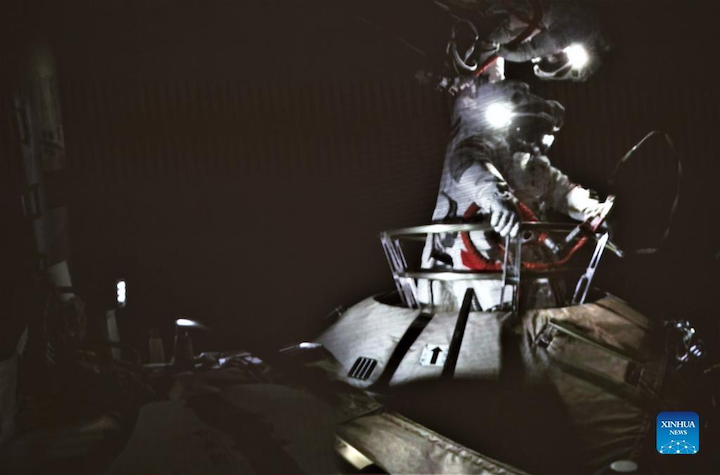
Screen image taken at Beijing Aerospace Control Center on Dec. 26, 2021 shows Chinese taikonaut Zhai Zhigang exiting the space station core module Tianhe. (Xinhua/Guo Zhongzheng)
Taikonauts Zhai Zhigang and Ye Guangfu have completed their extravehicular activities (EVAs) and returned to the space station core module Tianhe, the China Manned Space Agency said on early hours of Monday.
This was the fourth time that the taikonauts conducted EVAs during the construction of the country's space station and the second by the Shenzhou-13 crew. The CMSA has declared the EVAs a complete success.
The CMSA said the pair returned to the core module at 0:55 a.m. (Beijing Time) after about six hours of EVAs. They completed tasks such as lifting panoramic camera and testing goods transport.
The EVAs further tested the function and performance of the core module airlock cabin, extravehicular suit and mechanical arm, and assessed the technologies related to EVAs, the coordination of taikonauts inside and outside the space station, and the coordination between space and Earth.
The Shenzhou-13 crew will continue their in-orbit work to welcome the coming new year. This is also the first time that Chinese taikonauts welcome a new year in space, the CMSA added.
The CMSA noted that extravehicular operations are becoming the normal work of the space station flight missions. Chinese taikonauts will carry out more EVAs which are more complex to provide strong support for the successful completion of the construction and the stable operation of the space station.
China launched the Shenzhou-13 spaceship on Oct. 16, sending three taikonauts on a six-month mission to construct its space station. The crew conducted the first EVAs on Nov. 7. Enditem

Screen image taken at Beijing Aerospace Control Center on Dec. 27, 2021 shows a Chinese astronaut returning to the space station core module Tianhe after completing extravehicular activities (EVAs). Astronauts Zhai Zhigang and Ye Guangfu have completed their EVAs and returned to the space station core module Tianhe, the China Manned Space Agency said early Monday. This was the fourth time that Chinese astronauts conducted EVAs during the construction of the country's space station and the second by the Shenzhou-13 crew. The CMSA has declared the EVAs a complete success. (Xinhua/Guo Zhongzheng)
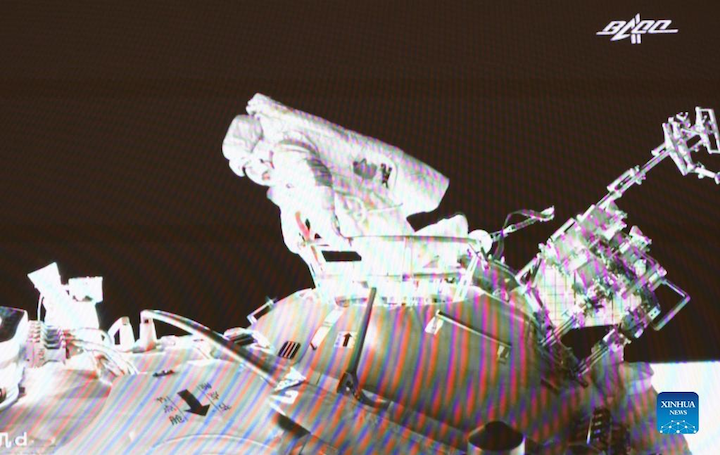
Screen image taken at Beijing Aerospace Control Center on Dec. 27, 2021 shows a Chinese astronaut returning to the space station core module Tianhe after completing extravehicular activities (EVAs). Astronauts Zhai Zhigang and Ye Guangfu have completed their EVAs and returned to the space station core module Tianhe, the China Manned Space Agency said early Monday. This was the fourth time that Chinese astronauts conducted EVAs during the construction of the country's space station and the second by the Shenzhou-13 crew. The CMSA has declared the EVAs a complete success. (Xinhua/Guo Zhongzheng)
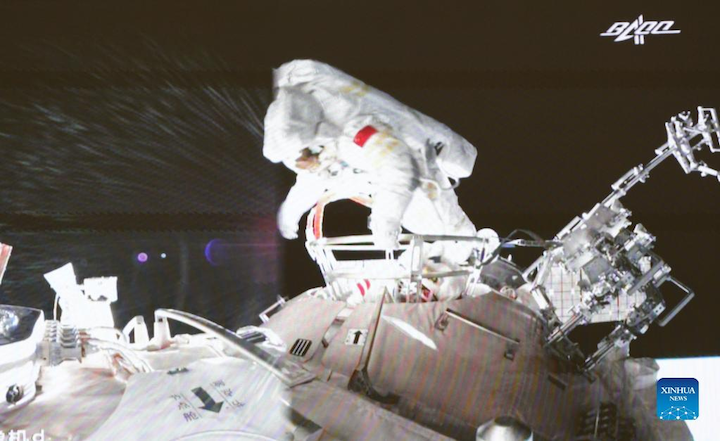
Screen image taken at Beijing Aerospace Control Center on Dec. 27, 2021 shows a Chinese astronaut returning to the space station core module Tianhe after completing extravehicular activities (EVAs). Astronauts Zhai Zhigang and Ye Guangfu have completed their EVAs and returned to the space station core module Tianhe, the China Manned Space Agency said early Monday. This was the fourth time that Chinese astronauts conducted EVAs during the construction of the country's space station and the second by the Shenzhou-13 crew. The CMSA has declared the EVAs a complete success. (Xinhua/Guo Zhongzheng)

Screen image taken at Beijing Aerospace Control Center on Dec. 26, 2021 shows Chinese taikonaut Wang Yaping working in the space station core module Tianhe. (Xinhua/Guo Zhongzheng)
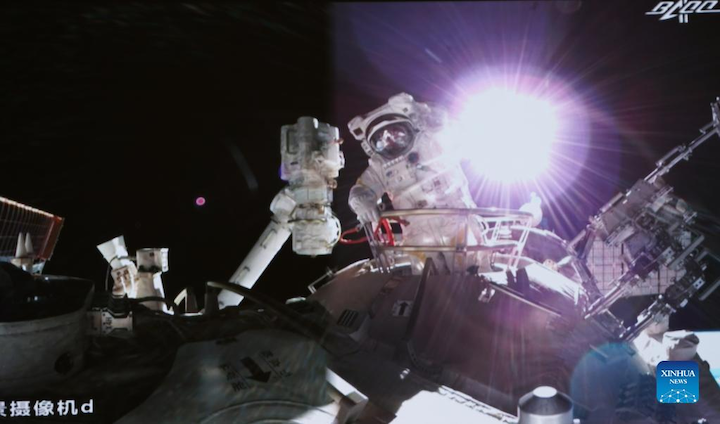
Screen image taken at Beijing Aerospace Control Center on Dec. 26, 2021 shows Chinese taikonaut Ye Guangfu exiting the space station core module Tianhe. (Xinhua/Guo Zhongzheng)
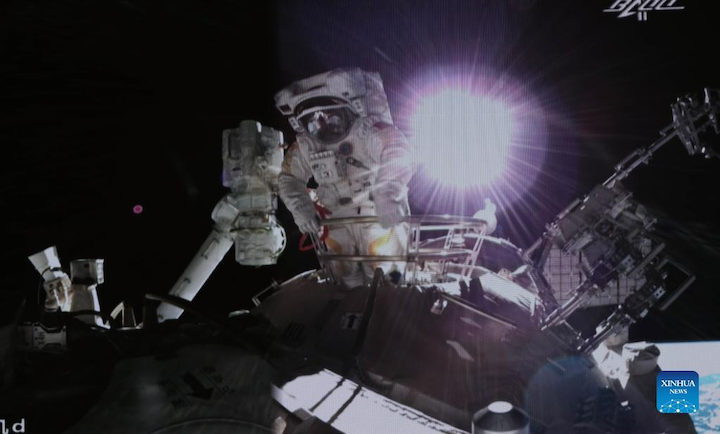
Screen image taken at Beijing Aerospace Control Center on Dec. 26, 2021 shows Chinese taikonaut Ye Guangfu exiting the space station core module Tianhe. (Xinhua/Guo Zhongzheng)
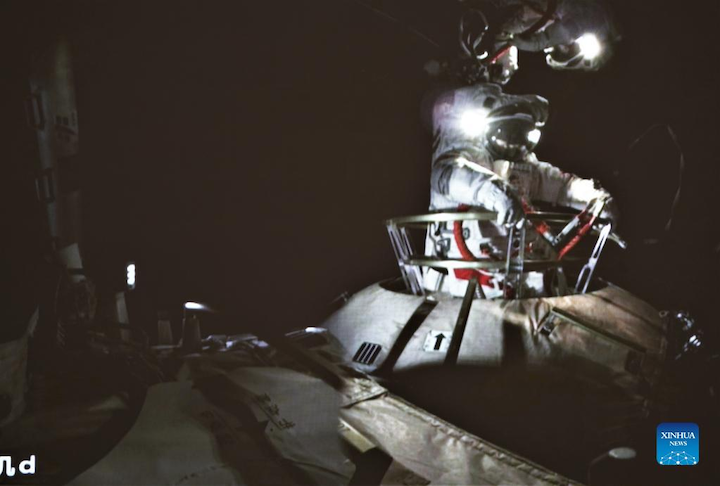
Screen image taken at Beijing Aerospace Control Center on Dec. 26, 2021 shows Chinese taikonaut Zhai Zhigang exiting the space station core module Tianhe.(Xinhua/Guo Zhongzheng)
China’s space station maneuvered to avoid Starlink satellites
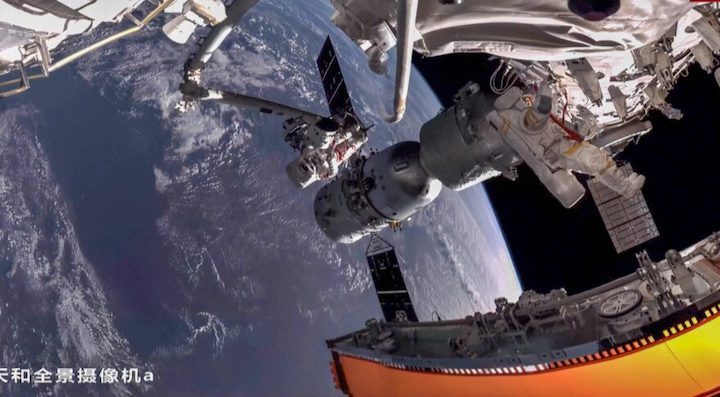
HELSINKI — China has informed the United Nations that its crewed space station twice maneuvered to avoid potential collisions with SpaceX Starlink satellites earlier this year.
A notification dated Dec. 6 by China under Article V of the Outer Space Treaty stated that the Tianhe space station module conducted preventive collision avoidance due to close approaches by the Starlink-1095 (2020-001BK) and Starlink-2305 (2021-024N) satellites on July 1 and Oct. 21 respectively.
Starlink satellites typically orbit at around 550 kilometers above the surface of the Earth, but the pair had lowered their altitudes, apparently as part of active deorbiting maneuvers at the end of the satellites’ life.
This saw the pair drift into the path of China’s Tianhe, the first module for the country’s space station. Both times Tianhe was inhabited, by the three-person crew of the Shenzhou-12 mission in July, and the ongoing Shenzhou-13 mission during the October close approach.
Satellite tracker Jonathan McDowell, of the Harvard-Smithsonian Center for Astrophysics, confirmed the two close approaches and avoidance burns using data published by U.S. space tracking. The October pass appears to have been within three kilometers.
The note from China requested the UN secretary-general to remind others that, “States Parties to the Treaty shall bear international responsibility for national activities in outer space, including the moon and other celestial bodies, whether such activities are carried on by governmental agencies or by non-governmental entities, and for assuring that national activities are carried out in conformity with the provisions set forth in the present Treaty.”
McDowell told SpaceNews via email that the “A/AC.105 UN series is usually ‘we did this, watch out,’ not ‘we are unhappy someone else did this,’ making this complaint very unusual.
“I expect people will go ‘um, you know the ISS had to dodge debris from the Chinese ASAT more than once too?’ But I think this is another sign we are in a qualitatively new era where the crowding of low Earth orbit is concerned,” McDowell noted.
SpaceX has so far not responded to a request for comment on the incident.
The company has launched nearly 1,950 Starlink satellites, of which about 1,800 are in orbit and providing internet services. SpaceX has plans for 12,000 satellites already approved by the U.S. Federal Communications Commission and has submitted paperwork for 30,000 more across a range of altitudes.
Reuters reported that Chinese internet users have heavily criticized Elon Musk over the incident, following Chinese media reporting on the maneuvers.
Global Times, a Beijing-based tabloid known for nationalistic screeds, cited a Chinese aerospace commentator Dec. 27, suggesting SpaceX possibly “aimed to test China’s sensibility in space” with the two close approaches.t
SpaceX’s Starlink project has been challenged and criticized, by competitors, astronomers, and others, with one industry official saying, “they don’t play well with others.”
The 22-metric-ton, 16.6-meter-long, and 4.2-meter-diameter Tianhe launched in April this year as the first of three modules to form the Tiangong space station. Two Tianzhou cargo spacecraft and the Shenzhou-13 spacecraft are currently docked with the module.
A Long March 2F and Shenzhou-14 spacecraft are in a state of near-readiness at the Jiuquan launch center in the Gobi Desert in case of emergency. Such a launch should be nine days according to reports.
China’s human spaceflight agency (CMSA), the Beijing Aerospace Flight Control Center (BACC), and the China Aerospace Science and Technology Corp. (CASC), have been working to establish the space station and adjust to the challenges of and gaining experience in operating long-term crewed missions in LEO, including cargo supply, spacewalks, and maintenance.
Being able to avoid debris requires being able to detect, track and predict courses of objects in low Earth orbit and be able to maneuver a spacecraft accordingly.
The International Space Station has been required to adjust its orbit to avoid debris numerous times, including due to fragments from a 2007 Chinese military destructive anti-satellite missile test—the largest debris-creating incident to date—as well as rocket upper stages from other countries.
In a further tweet, McDowell suggests the Starlink satellite involved in the July 1 encounter may have performed an avoidance burn, but communication may not have occurred.
A 2019 incident in which an ESA spacecraft dodged a Starlink satellite had earlier highlighted the need for coordination between satellite operators.
“It’s now gone beyond a question of whether we should trust their algorithms or not: with the highest percentage of operational LEO satellites now being owned and operated by Starlink, we have no choice but to trust their algorithms,” said Christopher Newman, professor of space law and policy at Northumbria University in the United Kingdom. “That causes real problems for governance when space diplomacy depends largely upon transparency.”
Low Earth orbit is becoming increasingly crowded, raising the risk of collisions. The growing debris problem threatens space infrastructure upon which many aspects of everyday life now depend.
Debris removal spacecraft and missions are in development, as are technologies and practices for reducing risk. Starlink is far from the only constellation that poses new challenges, however.
Other companies such as OneWeb and countries including China are also planning LEO megaconstellations. Earlier this year China created a company to manage the construction of a 13,000-satellite constellation for LEO communications.
China has so far not commented on a Nov. 15 Russia ASAT test which created debris that threatened the ISS. China’s foreign ministry spokesperson Zhao Lijian said in a Nov. 16 press conference that, “We noted relevant reports and that Russia has yet to respond. I think it is too early to make any comment.”
Quelle: SN
